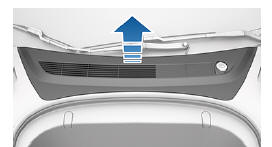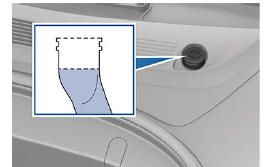Tesla Model 3: Fluid Reservoirs
To check fluid levels, remove the maintenance
panel:
Caution: The maintenance panel protects
the front trunk from water. When reattaching,
make sure it is fully seated. Checking Battery Coolant Your Battery coolant should not need to be
replaced for the life of your vehicle under
most circumstances. However, if the quantity
of fluid in the cooling system drops below the
recommended level, the touchscreen displays
a warning message. Stop driving Model 3 as
soon as safety permits and contact Tesla. Fluid Level Check DO NOT REMOVE THE FILLER CAP AND DO
NOT ADD FLUID. Doing so can result in
damage not covered by the warranty. Do Not Top Up Battery Coolant Warning: Battery coolant can be
hazardous and can irritate eyes and skin.
Under no circumstances should you
remove the filler cap and/or add coolant.
If the touchscreen warns you that the
fluid level is low, contact Tesla
immediately. To maximize the performance and life of the
Battery, the cooling system uses a specific
mixture of G-48 ethylene-glycol coolant
(HOAT). Contact Tesla for more specific
information about the coolant. Checking Brake Fluid Warning: Contact Tesla immediately if you
notice increased movement of the brake
pedal or a significant loss of brake fluid.
Driving under these conditions can result
in extended stopping distances or
complete brake failure.
Contact Tesla immediately. Topping Up the Brake Fluid Do not top up your brake fluid. The following
instructions are provided for information
purposes and future reference only: Warning: Only use new fluid from a sealed
air-tight container. Never use previously
used fluid or fluid from a previously
opened container-fluid absorbs moisture
which decreases braking performance. Warning: Brake fluid is highly toxic. Keep
containers sealed and out of the reach of
children. In the event of accidental
consumption, seek medical attention
immediately. Caution: Brake fluid damages painted
surfaces. Immediately soak up any spills
with an absorbent cloth and wash the
area with a mixture of car shampoo and
water. The only reservoir into which you can add fluid
is the windshield washer fluid reservoir, which
is located behind the front trunk. When the
level is low, a message displays on the
touchscreen.
To top up the washer fluid:
Note: Some national or local regulations
restrict the use of Volatile Organic
Compounds (VOCs). VOCs are commonly
used as antifreeze in washer fluid. Use a
washer fluid with limited VOC content only if it
provides adequate freeze resistance for all
climates in which you drive Model 3. Caution: Do not add formulated washer
fluids that contain water repellent or bug
wash. These fluids can cause streaking,
smearing, and squeaking or other noises. Warning: In temperatures below
40Вє F (4Вє C), use a washer fluid with
antifreeze. In cold weather, using a washer
fluid without antifreeze can impair
visibility through the windshield. Warning: Windshield washer fluid can
irritate eyes and skin. Read and observe
the instructions provided by the washer
fluid manufacturer.Removing the Maintenance Panel

 A red brake indicator on the
A red brake indicator on the
touchscreen alerts you if the
quantity of fluid in the brake
reservoir drops below the
recommended level. If it displays
while driving, stop as soon as safety
permits by gently applying the
brakes. Do not continue driving.
Topping Up Windshield Washer Fluid


